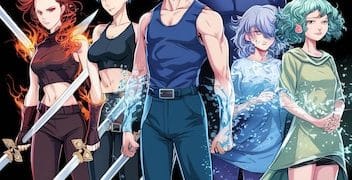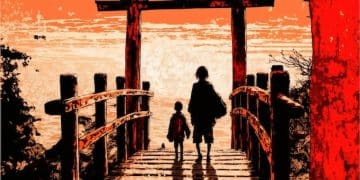From Page to Screen: A Critical Comparison of J-Dramas & Their Adaptations
From Page to Screen: A Critical Comparison of explores the intricate process of adapting Japanese dramas (J-Dramas) from their original source material, examining narrative fidelity, character portrayals, and the overall impact of these changes on audience reception.
The allure of Japanese dramas, or J-Dramas, lies not only in their compelling narratives but also in their diverse range of adaptations. The transition From Page to Screen: A Critical Comparison of becomes essential for understanding how these stories evolve and resonate with audiences.
The Art of Adaptation: J-Dramas and Their Source Material
Adaptation is both an art and a challenge, especially when bringing J-Dramas from their original forms to the screen. The essence of the story must be retained while considering the unique aspects of visual storytelling.
Understanding the Source Material
Bringing a J-Drama to life starts with understanding the underlying source material, be it a manga, novel, or even a video game. This requires not just reading or watching the source, but diving deep into its themes, characters, and overall message.
Challenges in Adapting J-Dramas
Adapting J-Dramas comes with its own set of unique challenges. One common hurdle is the translation of visual storytelling elements, such as manga panels, into live-action scenes. Another is capturing the cultural nuances present in Japanese stories for international audiences.
- Maintaining Narrative Coherence
- Balancing Originality with Source Fidelity
- Adapting Visual Storytelling

The adaptation process necessitates a delicate balance between staying true to the source material and making creative choices that enhance the viewing experience. Sometimes, deviations are necessary to meet production constraints or cater to audience preferences, but these changes should always serve the overall narrative.
Faithful Renditions: J-Dramas That Stayed True to the Original
Some J-Dramas are known for their faithful renditions of the original source material. These adaptations often appeal to fans of the original work, as they stay true to the core elements of the story.
Hana Yori Dango
One prime example is Hana Yori Dango, which has seen multiple adaptations across different countries. However, the Japanese version is often praised for its faithful portrayal of the manga’s characters and storyline.
Nodame Cantabile
Another popular J-Drama is Nodame Cantabile, which brilliantly captures the essence of its music-themed manga. The series accurately translates the manga’s humor, heart, and musical appreciation, making it a hit among fans and newcomers alike.
Faithful adaptations often succeed because they respect the original creator’s vision while adding value through skillful directing, acting, and production design. These dramas become a celebration of the source material, garnering praise from both critics and fans.
When Changes Work: J-Dramas That Successfully Diverged
Sometimes, changes to the original material can result in a J-Drama that stands out on its own. These adaptations might veer from the source to enhance pacing, character development, or thematic resonance.
Long Vacation
Long Vacation is a J-Drama that takes liberties with its original script, adding depth to the characters and providing compelling storylines that capture the attention of viewers. The show is a success due to its ability to stay intriguing while still following some of the main elements of the original story.
GTO: Great Teacher Onizuka
Another example includes GTO: Great Teacher Onizuka, which, despite its over-the-top comedic elements, delivers a heartfelt story about teaching. This adaptation manages to balance humor and emotion, making it a popular choice among viewers.
- Enhancing Pacing for Television
- Adding Depth to Characters
- Resonating Thematically with Modern Audiences
The success of dramatizations that diverge from the source material often depends on the creative team’s ability to understand the core themes and adapt them in a way that resonates with a wider audience. These adaptations can introduce new fans to the original source while offering a fresh viewing experience.

The Role of Cultural Nuances in Adaptation
Cultural nuances play a significant role in adapting J-Dramas. These adaptations need to be sensitive to the cultural context, making sure that the story remains respectful and authentic.
Preserving Japanese Culture
Preserving Japanese culture in J-Dramas involves more than just setting the scene in Japan; it requires attention to small details, such as etiquette, language, and social norms. Authenticity can significantly enhance the viewing experience for both local and international audiences.
Adaptation for International Audiences
Adapting J-Dramas for international audiences requires some cultural tweaking. The humor, relationships, and social interactions within the story need to be presented in a way that can be understood and appreciated by those unfamiliar with Japanese culture.
The goal is to strike a balance between cultural accuracy and widespread appeal. Adaptations that successfully navigate these cultural considerations tend to resonate more deeply with viewers, both locally and globally.
Critical Reception: Fan Responses to J-Drama Adaptations
Critical reception of J-Drama adaptations is a key indicator of success. Fan responses can make or break an adaptation, as their opinions often influence viewership and overall popularity.
Positive Feedback and Praise
Dramas that are praised for their faithful adaptation and high production values tend to receive positive feedback from fans. These series often generate buzz on social media and contribute to the overall success of the adaptation. Fans want to see the original well respected.
Criticisms and Controversies
Adaptations that stray too far from the source or mishandle key characters often face criticism. Controversial adaptations can lead to negative reviews, lower viewership, and a damaged reputation for the production team.
It is helpful to take criticism seriously, adjusting series based on fan and critic feedback, if possible. Overall, it improves not only the current reception, but also shows the producers care for the core message of the original story.
The Future of J-Drama Adaptations: Trends and Predictions
The future of J-Drama adaptations looks promising as more stories are being brought to the screen. New technologies and storytelling techniques continue to shape how J-Dramas are adapted and consumed.
Emerging Trends in Adaptation
One emerging trend is the use of CGI and special effects to bring fantastical elements from manga to life. Another trend is the rise of international co-productions, which allow for J-Dramas to reach a wider global audience.
Predictions for Future Adaptations
Future adaptations will likely focus on telling diverse stories that mirror modern issues while staying true to Japanese storytelling traditions. As streaming services continue to grow, J-Dramas will have more opportunities to connect with audiences around the world.
Ultimately, the future of J-Drama adaptations depends on the creative teams’ ability to honor the source material, leverage new technologies, and connect with audiences on a global scale.
| Key Point | Brief Description |
|---|---|
| 📚 Source Material | Understanding themes, characters, and message. |
| 🎯 Faithful Renditions | Respecting original creator’s vision. |
| 🎭 Successful Divergences | Enhancing pacing and character depth. |
| 🌍 Cultural Nuances | Balancing accuracy and widespread appeal. |
Frequently Asked Questions
▼
A successful J-Drama adaptation balances faithfulness to the source material with creative enhancements. It resonates with both fans of the original work and new viewers, capturing the essence of the story in a compelling way.
▼
Cultural accuracy is very important. It ensures the adaptation remains respectful and authentic, enhancing the viewing experience. Attention to cultural details adds depth and credibility, making the story more engaging for viewers.
▼
Common challenges include translating visual storytelling from manga to live-action, handling cultural nuances for international audiences, and balancing originality with source fidelity. Production constraints and budgetary limitations also pose additional difficulties.
▼
Fan responses play a crucial role in gauging the success of adaptations. Positive feedback and praise can lead to increased viewership and popularity, while criticisms and controversies can damage the production’s reputation. The audience’s reaction holds immense power.
▼
Emerging trends include the use of advanced CGI and special effects, international co-productions, and a focus on diverse stories that reflect modern issues. These trends provide new avenues for J-Dramas to connect with global audiences.
Conclusion
Ultimately, the journey From Page to Screen: A Critical Comparison of J-Dramas exemplifies the dynamic interplay between adaptation, culture, and audience reception. Whether a faithful rendition or a bold reimagining, the goal remains to create a compelling narrative that resonates with viewers while honoring its source.





